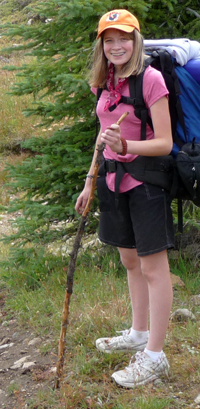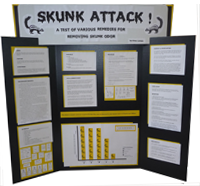Tackling a Stinky Situation: A Student Science Success Story
Kate Lande hasn't ever run into a skunk, but thanks to her 6th grade science project, she knows all about the role of oxidation in combatting stinky smells.

Student Science in the Real World
As a 6th grade student, Kate Lande (pictured above) put an old folk remedy for getting rid of skunk spray smell to the test. She later discovered that her science research came in handy when her dog rolled in a decaying octopus!

Sharing the Results
A Project Display Board, like Kate's shown above, is an important part of the school science fair project. Find tips for presenting your data and constructing your board in the Science Fair Project Display Boards resource.
At Science Buddies, we know that the idea for a great student science project can come from anywhere. Something a student sees on TV may spark a question. A favorite hobby may inspire an experiment. A family health challenge may guide student inquiry. Science projects can be constructed around and about anything, even something that totally stinks!
After watching episodes of MythBusters and Fetch! (PBS KIDS GO) about treating and removing skunk smell, Kate Lande, then a 6th grade student in Washington, got inspired to tackle her own smelly science chemistry experiment.
"It looked like a pretty crazy project," recalls Kate, "but I decided to try it anyway."
Inspired by the challenge of getting rid of skunk smell, a smell notorious for its noxious, lasting power, Kate crafted her experiment for her required 6th grade science fair project. Tomato juice is a well-known folk remedy for skunk spray smell. We've all seen sitcoms where a family pet—or family member—ends up soaking in a tub of tomato juice after an unfortunate run-in with a black and white striped bandit. But does this remedy really work? Is tomato juice really an effective approach to remove the smell from something that has been skunk sprayed? And, is it the best way to get rid of skunk odor?
That there are no skunks where she lives didn't stop Kate from digging into the chemistry of the smelly problem. "I've never seen a real skunk, but I've smelled skunk spray on some of the road trips I've taken with my family," says Kate. After working with imitation skunk spray for her project, the scent is firmly rooted in Kate's head. "To me, it smells like an awful mix of burned rubber, rotten eggs, and skunk cabbage (a type of plant that grows in swampy areas—it really does smell like skunk, and there's lots of it [in my area]! In wild areas, bears love to eat it.)."
Anxious to put folk wisdom about tomato juice to the test—and to pit it against other potential remedies—Kate got started. Her background research on thiols and oxidation gave her a strong sense of what she thought would happen and how her test remedies would perform. She set up her hypothesis, designed her experiment, and called upon some volunteer noses.
What was the hardest part about experimenting with methods of skunk odor removal? "It was definitely a challenge to work with the skunk spray liquid," says Kate, "both to keep it off of myself and to tolerate the terrible smell!" She did it, and when she was finished, she contacted Science Buddies to share her project.
Smelly Science at Science Buddies
Inspired by Kate's stinky science project, Science Buddies staff scientists used Kate's investigation during the development of a new Project Idea at Science Buddies. Today, students interested in wildlife, chemistry, or just smelly science, may undertake the Skunk Attack! Test Different Remedies to Remove Skunk Odor science project and get hands-on with different ways to neutralize (or oxidize) thiols, the class of chemical compounds into which skunk spray smell falls.
Kate is excited that an adaptation of her science project idea is now available at Science Buddies for other students. "It feels pretty cool," she says. "I'm proud that my project idea was an original and that I did it well enough to be listed on an actual science website."
For students who decide to investigate skunk spray, she cautions, "This is definitely an outdoor project. We live on a big farm, so we picked an area well away from our house to do the experiment."
Kate also says to keep in mind that skunk spray may be just the beginning! She found that the odor remover she tried also works in other smelly situations. "Like the time our Labrador rolled in a dead octopus," says Kate. "We were walking on one of Vashon Island's beaches, and she found the octopus and rolled in it before we could stop her. She smelled horrible!"
After checking with the local veterinarian, Kate got instructions for using the odor remover safely on her dog, and it worked. "The solution also works on horse and sheep manure. Since we live on a farm, there's plenty of manure, and sometimes our dog rolls in it (but not very often, thankfully!)."
What odor remover did Kate test and discover to be effective at removing a range of stinky smells? You will have to conduct your own chemistry experiment to find out. In the Skunk Attack! Test Different Remedies to Remove Skunk Odor science project, you and your volunteers can do a sniff test to see which of four different possible remedies is most effective—and why. The nose knows best, but when it comes to skunk smell, chemistry holds the key to successfully "destink" the situation!
This year, Kate's 8th grade science project involved measuring the amount of sugar in soda. If you want to explore the science of that sweet subject, see the How Sweet It Is—How Much Sugar Is Really in That Soda? project.
In her spare time, Kate loves to read, write, draw, and make videos with friends and family. She also enjoys being outdoors, exploring nature, camping, and hiking. One of her goals is to climb Mount Rainier.
Categories:
You Might Also Enjoy These Related Posts:
- Making Recycling Sorting Machines—STEM Success
- Mini Trebuchets and a NM MESA Challenge
- Helping Students Build Coding Skills with Drones and Self-Driving Cars
- Middle School Student Codes to Improve Life with Visual Impairment
- Student Science Project - Designing and Coding a Video Game to Help People with Alzheimer's
- Teacher Combines Computer Science and Engineering Design for Middle School Students - STEM Success Story
- A Mirror Maze Success Story
- Paper Roller Coasters and Energy Transformation: STEM Teacher Success Story









